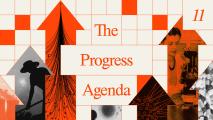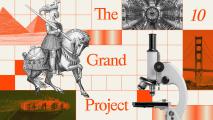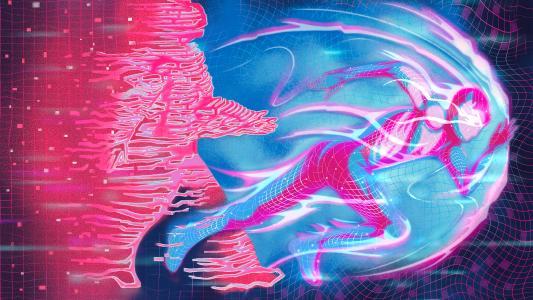You’ll notice it first as a presence.
A soft chime in your ear as you step out the door: “Rain in 23 minutes; the zig-zag alley keeps you dry.”
It isn’t an app, and it’s not a device you have to tap commands into.
It’s ambient AI — not quite Samantha from “Her,” but not far from it.
The era of ambient AI
We’re on the cusp of a Cambrian explosion of intelligence, but it won’t be the fever-dream rapid recursive self-improvement nightmare envisioned by catastrophic AI theorists. It won’t be a world decimated by job losses overnight, either. Historically, technological advances create more jobs than they destroy, though it’s rarely obvious what those jobs will be at the time — computers took jobs from bookkeepers, but created new roles managing, analyzing, and building the very systems that replaced them.
This intelligence explosion will dramatically change how we experience technology, though it won’t happen overnight — instead of a thunderclap, it’ll be a thousand tiny little shifts that you barely notice until you’re living a totally different way, and you can’t even remember the old way anymore.
The age of apps will die a slow heat death. Those ubiquitous tiny squares on a phone or desktop we have to tap to open will fade into the background, disappearing forever, as we enter the age of the AI agent: a context-aware collaborator that closes the gap between intent and action. It will wield the apps for us now: setting appointments, sending messages, booking reservations. It won’t have human-level consciousness, but we’ll probably call it AGI anyway.
It’s always watching, but it’s not Big Brother. It’s practical, personal, intimate.
Because it’s baked into wearables, we won’t have to stop what we’re doing to interact with our AI agent. Instead of pulling out a phone, we’ll whisper into the air, blink twice, or tap the rim of our smart glasses, and our digital best buddy will then sort the frantic chaos of our lives into soft music.
It’s always watching, but it’s not Big Brother. It’s practical, personal, intimate. A friend. It knows us because it’s been with us for huge stretches of our lives, erasing the tiny frictions of the day, ripping away the rote work and the extra steps that it currently takes to do everything, streaming its memories of us to an encrypted database cluster in the sky.
The technology to make this future possible is coming together faster and faster, and the foundation of it is already here.
Meta has sold two million pairs of its Ray-Ban AI glasses, and it now has a second offering with its super stylish Oakley offshoot. Those shades come with batteries that deliver eight hours of use, plus a case that can keep the glasses charged for up to 48 hours. In 2024, Mojo Vision demonstrated a 14,000-ppi micro-LED display that fits inside a scleral lens the size of a cornflake. Ion Storage Systems is firing up a new Maryland facility to produce solid-state batteries that last 50% longer than today’s lithium-ion cells while being immune to the thermal runaway that plagued early wearables.
This progress under the hood will continue at a steady pace until it all comes together in a way that just works. In the coming years, we’re going to see smaller, longer lasting batteries and new kinds of chips, including ones that conserve power by merging biology with technology. Edge AI processors will get stronger and more energy efficient — processing will hop back and forth, with heavy lifts taking place in the cloud, while quick reflexive reactions happen locally.
Work feels less like juggling windows and more like a focused conversation. The drudgery of calendar management is gone.
Rocket forward with me 10 or 20 years to an average day in this era of ambient AI:
7:00 am – Up and at ’em: A subtle vibration from your necklace, not an alarm. “Stand, stretch, hydrate,” says Gabby, the name you gave your personal OS when she fired up for the first time. She’s not really a single model, but a network of models that all feel like the same “person” to you. Her voice is sweet but direct, tuned to perfection on years of your voice notes, so her words feel like self-talk, not nagging.
She’s gathered sleep metrics overnight. A tailored 30-minute workout is queued up on the living room screen before your feet find your shoes. Your glucose and heart rate trends have been cross-checked. If last night’s readings looked off, a summary was routed to your doctor’s portal before the coffee was even done brewing.
9:00 am – The predictive commute: You kiss your wife as both of you head out to your one day at the office. As you step out the door, you slip on your glasses. The curb glows a soft, pulsing teal, Gabby subtly guiding you to a good place to catch a self-driving cab.
Personalized music plays on your earbuds — it’s generated on the fly, based on songs you loved. You step out of the cab and run into a new co-worker. What was her name again? Gabby gracefully mutes your soundtrack as you say hello and discretely displays an intro Slack thread beside the co-worker’s face for a split second — just long enough to jog your memory.
10:15 am – The end of office triage: Work feels less like juggling windows and more like a focused conversation. The drudgery of calendar management is gone. Gabby already clustered meetings by decision weight, politely declining the non-essential ones. She also drafted a slide deck for the big pitch — you go over the slides, improving five and deleting one.
11:45 am – Time to talk: You’re in the middle of a podcast interview, and the words are flowing easily. A teleprompter — invisible to everyone but you — scrolls with perfect timing across your line of sight, displaying relevant notes and ideas in response to the questions you’re asked. This isn’t a crutch — it’s Gabby freeing you to make more eye contact, to connect, to persuade.
2:00 pm – Curiosity satisfied: You eat a quick lunch at a restaurant Gabby recommends based on a local food critic’s vlog. As you walk back to the office, you notice a statue in a quiet plaza — a blink summons its history in three crisp sentences.
5:30 pm – Love life logistics: It’s Friday night, and you ping your wife. She’s off soon, and you want to surprise her with a nice dinner. You whisper into the air: “I want a quiet place with natural wine that’s less than a 20-minute stroll from here.”
A few seconds later, Gabby shows you three possibilities. You pick one, and within minutes, Gabby has booked a reservation. She also notes that your wife’s favorite local band is playing a concert in town that night. “Buy tickets.”
8:00 pm – In the moment: The crowd at the concert stares rapt at the stage, not a single phone held aloft. Most attendees are wearing lenses that, like yours, auto-record the last 30 seconds of what they see on a loop. A long blink or tap of the frame stores the previous moment in the cloud, encrypted and locked away behind two-factor authentication — everything else evaporates. The look of sheer joy on your wife’s face locks into your real memory forever.
Skeptics and hypesters
The path to success is historically littered with the carcasses of well-intentioned failures — it took more than 20 inventors 40 years to finally bring the lightbulb from prototype to usable product — but with each failed attempt to make the future detailed above a reality, skeptics come out to scream that ambient AI will never work.
“Just look at how badly the original Google Glass flopped,” they say before pointing to the string of bodies since: Humane’s AI Pin was fire-sold to HP. The Rabbit R1 looked like a beautiful throwback to the Fun Tech era, but as Mark Spoonauer, editor-in-chief of Tom’s Guide, wrote, it was “unfinished and broken” on release.
On the other side of the spectrum from the skeptics, we have the hypesters who tell us we’re just a year or two away from having AI companions comparable to Samantha in our pockets, while “a country of geniuses in a data center” solves everything from nuclear fusion to incurable cancers. They tell us it’s all happening suddenly and at lightning speed.
Failure is fertilizer. Each flop clarifies the path forward.
It’s really not, though — AI research began roughly 75 years ago. Advances are happening faster now, but people underestimate how often exponential curves become S curves. We’re hill climbing quickly at the moment because a lot of pieces just came together — big data, better chips, better algos — but we’ll get to the top and see more mountains in the distance.
That’s the nature of engineering. Step by step. It takes time and iterations and a thousand little breakthroughs that all eventually come together into the perfect gadgets later on down the line. This is the long, slow, inevitable trendline that trumps the flashy headlines of failure. It’s how progress works. Failure is fertilizer. Each flop clarifies the path forward, teaching the market what not to do: Don’t ship before the model is house-trained, like Rabbit. Don’t bet on monthly fees when the core functionality of a phone is free, like Humane did with their pin.
Meta’s Ray Bans are already far more functional than Google Glass, and its new white Oakleys are far more stylish. Even the recent hardware flops aren’t total failures: A year after the R1’s slow start, it turned the corner with an updated Tom’s Guide review calling it “sort of finished and not broken anymore,” and the Humane Pin lives on with an open-source OS as an SDK experiment.
On the timeline of the universe, the journey from here to there will pass in a blink of an eye.
Are any of these gadgets today likely to be the one that breaks through, the iPhone moment for AI wearables? Probably not. Product-market fit is iteratively bruising business. Ask the cell phone pioneers. It was a long time from this 1963 newspaper article that predicted a phone in your pocket to the heavy, clunky DynaTAC 8000x released in 1983, with limited battery and call time, to the days of the Motorola Razr flip phones in 2004, to the iPhone in 2007.
But ambient AI is coming. Step by step, inch by inch. Twelve months from now, a decade, or 20 years — it doesn’t matter. We are heading toward a future where an AI assistant is a constant presence — always there, always on, always ready to help.
On the timeline of the universe, the journey from here to there will pass in a blink of an eye — and that means we need to do the work right now to address the biggest potential pitfall to having an AI embedded in nearly every aspect of our lives: invasions of privacy.
If we get the privacy right, ambient AI will be a tool for flourishing, not exploitation.
Encryption is vital to digital privacy, but governments seem determined to break it. Every few years like clockwork, they propose short-sighted backdoor mandates that would give law enforcement agencies and other “good guys” access to your data — even as experts warn that bad guys, like Salt Typhoon, can and will exploit the same entry points. Compromise encryption to catch a few criminals, and you compromise it for banks, e-commerce platforms, and everyone else, too.
Apple has been criticized for the slow rollout of its Apple Intelligence features, but it’s already illustrating how we could ensure ambient AI doesn’t become a persistent surveillance device. Anything that isn’t processed directly on Apple’s devices is flexed to dedicated cloud servers. Everything is end-to-end encrypted prior to transit, and data is discarded immediately after processing. During it, users’ identities are obscured cryptographically — it’s a privacy framework built on math, not marketing.
If we can get the privacy right, the age of agents will be an age of celebration, not an age of digital surveillance and surveillance capitalism.
Either way, though, that age is coming, slowly and then all at once. We’re building a future where the most powerful technology in history is woven right into the very fabric of everyday life, and if we make sure to make privacy the center of it all, ambient AI will be a tool for flourishing, not exploitation. A universe of knowledge and capability will hum gently in the background of our lives, ready when we need it, and invisible when we don’t.
And we’ll finally stop staring down at slabs of glass and start looking through our own eyes again — at the world and at each other.
We’d love to hear from you! If you have a comment about this article or if you have a tip for a future Freethink story, please email us at [email protected].






